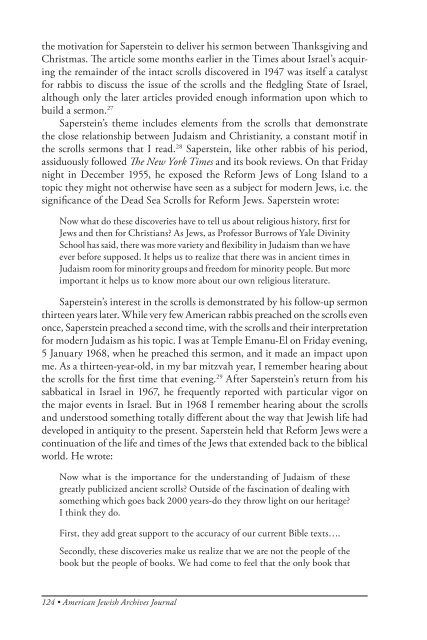The American Jewish Archives Journal, Volume LXI 2009, Number 1
The American Jewish Archives Journal, Volume LXI 2009, Number 1
The American Jewish Archives Journal, Volume LXI 2009, Number 1
Create successful ePaper yourself
Turn your PDF publications into a flip-book with our unique Google optimized e-Paper software.
the motivation for Saperstein to deliver his sermon between Thanksgiving and<br />
Christmas. <strong>The</strong> article some months earlier in the Times about Israel’s acquiring<br />
the remainder of the intact scrolls discovered in 1947 was itself a catalyst<br />
for rabbis to discuss the issue of the scrolls and the fledgling State of Israel,<br />
although only the later articles provided enough information upon which to<br />
build a sermon. 27<br />
Saperstein’s theme includes elements from the scrolls that demonstrate<br />
the close relationship between Judaism and Christianity, a constant motif in<br />
the scrolls sermons that I read. 28 Saperstein, like other rabbis of his period,<br />
assiduously followed <strong>The</strong> New York Times and its book reviews. On that Friday<br />
night in December 1955, he exposed the Reform Jews of Long Island to a<br />
topic they might not otherwise have seen as a subject for modern Jews, i.e. the<br />
significance of the Dead Sea Scrolls for Reform Jews. Saperstein wrote:<br />
Now what do these discoveries have to tell us about religious history, first for<br />
Jews and then for Christians? As Jews, as Professor Burrows of Yale Divinity<br />
School has said, there was more variety and flexibility in Judaism than we have<br />
ever before supposed. It helps us to realize that there was in ancient times in<br />
Judaism room for minority groups and freedom for minority people. But more<br />
important it helps us to know more about our own religious literature.<br />
Saperstein’s interest in the scrolls is demonstrated by his follow-up sermon<br />
thirteen years later. While very few <strong>American</strong> rabbis preached on the scrolls even<br />
once, Saperstein preached a second time, with the scrolls and their interpretation<br />
for modern Judaism as his topic. I was at Temple Emanu-El on Friday evening,<br />
5 January 1968, when he preached this sermon, and it made an impact upon<br />
me. As a thirteen-year-old, in my bar mitzvah year, I remember hearing about<br />
the scrolls for the first time that evening. 29 After Saperstein’s return from his<br />
sabbatical in Israel in 1967, he frequently reported with particular vigor on<br />
the major events in Israel. But in 1968 I remember hearing about the scrolls<br />
and understood something totally different about the way that <strong>Jewish</strong> life had<br />
developed in antiquity to the present. Saperstein held that Reform Jews were a<br />
continuation of the life and times of the Jews that extended back to the biblical<br />
world. He wrote:<br />
Now what is the importance for the understanding of Judaism of these<br />
greatly publicized ancient scrolls? Outside of the fascination of dealing with<br />
something which goes back 2000 years-do they throw light on our heritage?<br />
I think they do.<br />
First, they add great support to the accuracy of our current Bible texts….<br />
Secondly, these discoveries make us realize that we are not the people of the<br />
book but the people of books. We had come to feel that the only book that<br />
124 • <strong>American</strong> <strong>Jewish</strong> <strong>Archives</strong> <strong>Journal</strong>

















